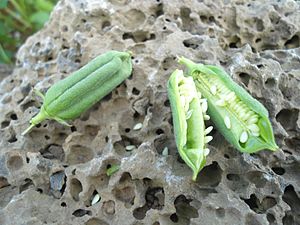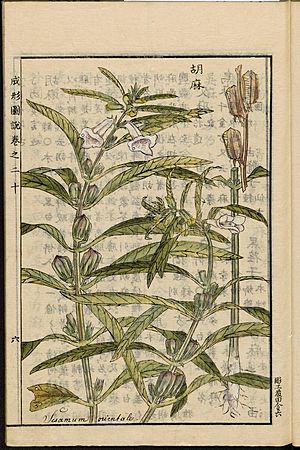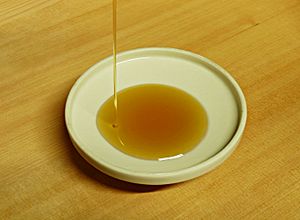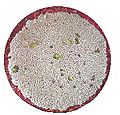Sesame facts for kids
Quick facts for kids Sesame |
|
|---|---|
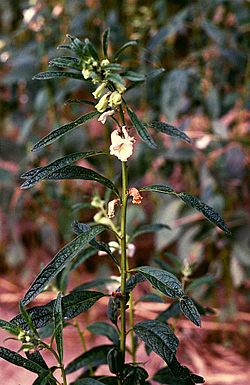 |
|
| Sesame plants | |
| Scientific classification | |
| Kingdom: | |
| Division: | |
| Class: | |
| Order: | |
| Family: | |
| Genus: | |
| Species: |
S. indicum
|
| Binomial name | |
| Sesamum indicum |
|
Sesame ( Sesamum indicum) is a flowering plant in the genus Sesamum, also called benne. Numerous wild relatives occur in Africa and a smaller number in India. It is widely naturalized in tropical regions around the world and is cultivated for its edible seeds, which grow in pods. World production in 2016 was 6.1 million tonnes, with Tanzania, Myanmar, India, and Sudan as the largest producers.
Sesame seed is one of the oldest oilseed crops known, domesticated well over 3000 years ago. Sesamum has many other species, most being wild and native to sub-Saharan Africa. S. indicum, the cultivated type, originated in India and is tolerant to drought-like conditions, growing where other crops fail.
Sesame has one of the highest oil contents of any seed. With a rich, nutty flavor, it is a common ingredient in cuisines across the world. Like other nuts and foods, it can trigger allergic reactions in some people.
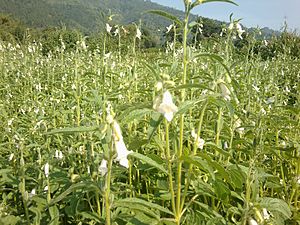
Sesame seeds are sometimes sold with the seed coat removed (decorticated); this variety is often present on top of baked goods in many countries.
Origins
Sesame seed is considered to be the oldest oilseed crop known to humanity. The genus has many species, and most are wild. Most wild species of the genus Sesamum are native to sub-Saharan Africa. S. indicum, the cultivated type, originated in India.
Archaeological remnants suggest sesame was first domesticated in the Indian subcontinent dating to 5500 years ago. Charred remains of sesame recovered from archeological excavations have been dated to 3500-3050 BC. Fuller claims trading of sesame between Mesopotamia and the Indian subcontinent occurred by 2000 BC . It is possible that the Indus Valley Civilization exported sesame oil to Mesopotamia, where it was known as ilu in Sumerian and ellu in Akkadian. One theory is that these words derive from the Dravidian name for sesame (el or ellu).
Some reports claim sesame was cultivated in Egypt during the Ptolemaic period, while others suggest the New Kingdom . Egyptians called it sesemt, and it is included in the list of medicinal drugs in the scrolls of the Ebers Papyrus dated to be over 3600 years old. Archeological reports from Turkey indicate that sesame was grown and pressed to extract oil at least 2750 years ago in the empire of Urartu.
The historic origin of sesame was favored by its ability to grow in areas that do not support the growth of other crops. It is also a robust crop that needs little farming support—it grows in drought conditions, in high heat, with residual moisture in soil after monsoons are gone or even when rains fail or when rains are excessive. It was a crop that could be grown by subsistence farmers at the edge of deserts, where no other crops grow. Sesame has been called a survivor crop.
Botany
Sesame is an annual plant growing 50 to 100 cm (1.6 to 3.3 ft) tall, with opposite leaves 4 to 14 cm (1.6 to 5.5 in) long with an entire margin; they are broad lanceolate, to 5 cm (2 in) broad, at the base of the plant, narrowing to just 1 cm (0.4 in) broad on the flowering stem. The flowers are white, tubular, 3 to 5 cm (1.2 to 2.0 in) long, with a four-lobed mouth. The flowers may vary in colour, with some being white, blue, or purple. Sesame seeds occur in many colours depending on the cultivar. The most traded variety of sesame is off-white coloured. Other common colours are buff, tan, gold, brown, reddish, gray, and black. The colour is the same for the hull and the fruit.
Sesame fruit is a capsule, normally pubescent, rectangular in section, and typically grooved with a short, triangular beak. The length of the fruit capsule varies from 2 to 8 cm, its width varies between 0.5 and 2.0 cm, and the number of loculi varies from four to 12. The fruit naturally splits open (dehisces) to release the seeds by splitting along the septa from top to bottom or by means of two apical pores, depending on the varietal cultivar. The degree of dehiscence is of importance in breeding for mechanised harvesting, as is the insertion height of the first capsule.
Sesame seeds are small. Their sizes vary with the thousands of varieties known. Typically, the seeds are about 3 to 4 mm long by 2 mm wide and 1 mm thick. The seeds are ovate, slightly flattened, and somewhat thinner at the eye of the seed (hilum) than at the opposite end. The weight of the seeds is between 20 and 40 mg. The seed coat (testa) may be smooth or ribbed.
Cultivation
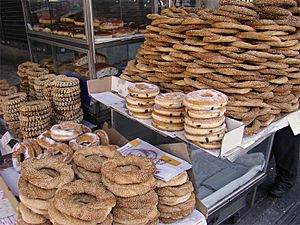
Sesame varieties have adapted to many soil types. The high-yielding crops thrive best on well-drained, fertile soils of medium texture and neutral pH. However, these have low tolerance for soils with high salt and water-logged conditions. Commercial sesame crops require 90 to 120 frost free days. Warm conditions above 23 °C (73 °F) favor growth and yields. While sesame crops can grow in poor soils, the best yields come from properly fertilized farms.
Initiation of flowering is sensitive to photoperiod and sesame variety. The photoperiod also affects the oil content in sesame seed; increased photoperiod increases oil content. The oil content of the seed is inversely proportional to its protein content.
Sesame is drought-tolerant, in part due to its extensive root system. However, it requires adequate moisture for germination and early growth. While the crop survives drought and presence of excess water, the yields are significantly lower in either conditions. Moisture levels before planting and flowering impact yield most.
Most commercial cultivars of sesame are intolerant of water-logging. Rainfall late in the season prolongs growth and increases loss to dehiscence, when the seedpod shatters, scattering the seed. Wind can also cause shattering at harvest.
Processing
Sesame seeds are protected by a capsule that only bursts when the seeds are completely ripe (dehiscence). The dehiscence time tends to vary, so farmers cut plants by hand and place them together in an upright position to continue ripening until all the capsules have opened. The discovery of an indehiscent mutant (analogous to nonshattering domestic grains) by Langham in 1943 began the work towards development of a high-yielding, dehiscence-resistant variety. Although researchers have made significant progress in sesame breeding, harvest losses due to dehiscence continue to limit domestic US production.
Since sesame is a small, flat seed, it is difficult to dry it after harvest because the small seed makes movement of air around the seed difficult. Therefore, the seeds need to be harvested as dry as possible and stored at 6% moisture or less. If the seed is too moist, it can quickly heat up and become rancid.
After harvesting, the seeds are usually cleaned and hulled. In some countries, once the seeds have been hulled, they are passed through an electronic colour-sorting machine that rejects any discolored seeds to ensure perfect colour, because sesame seeds with consistent appearance are perceived to be of better quality by consumers, and sell for a higher price.
Immature or off-sized seeds are removed and used for sesame oil production.
Culinary
Sesame seed is a common ingredient in various cuisines. It is used whole in cooking for its rich, nutty flavour. Sesame seeds are sometimes added to breads, including bagels and the tops of hamburger buns. They may be baked into crackers, often in the form of sticks. In Sicily and France, the seeds are eaten on bread (ficelle sésame, sesame thread). In Greece, the seeds are also used in cakes.
Fast-food restaurants use buns with tops sprinkled with sesame seeds. About 75% of Mexico's sesame crop is purchased by McDonald's for use in their sesame seed buns worldwide.
In Asia, sesame seeds are sprinkled onto some sushi-style foods. In Japan, whole seeds are found in many salads and baked snacks, and tan and black sesame seed varieties are roasted and used to make the flavouring gomashio. East Asian cuisines, such as Chinese cuisine, use sesame seeds and oil in some dishes, such as dim sum, sesame seed balls (Cantonese: jin deui), and the Vietnamese bánh rán. Sesame flavour (through oil and roasted or raw seeds) is also very popular in Korean cuisine, used to marinate meat and vegetables. Chefs in tempura restaurants blend sesame and cottonseed oil for deep-frying.
Sesame, or simsim as it is known in East Africa, is used in African cuisine. In Togo, the seeds are a main soup ingredient and in the Democratic Republic of the Congo and in the north of Angola, wangila is a dish of ground sesame, often served with smoked fish or lobster.
Sesame seeds and oil are used extensively in India. In most parts of the country, sesame seeds mixed with heated jaggery, sugar, or palm sugar is made into balls and bars similar to peanut brittle or nut clusters and eaten as snacks. In Manipur, black sesame is used in the preparation of chikki and cold-pressed oil. In Assam, black sesame seeds are used to make til pitha and tilor laru (sesame seed balls), as well as used with meat to cook til mangko during bihu. In Punjab and Tamil Nadu, a sweet ball called pinni in Urdu and ell urundai in Tamil, ellunda in Malayalam, yellunde/Chigali, (sesame ball, usually in jaggery), is made of its seeds mixed with sugar. It is eaten in various forms during the festival of Makar Sankranti.
Also in Tamil Nadu, sesame oil used extensively in their cuisine, milagai podi, a ground powder made of sesame and dry chili, is used to enhance flavor, and is consumed along with other traditional foods such as idli. In Tamil Nadu and Andhra Pradesh, sesame oil is used as a preservative and to temper the heat of their spicy foods, pickles, and condiments.
Sesame seed cookies and wafers, both sweet and savory, are popular in places such as Charleston, South Carolina. Sesame seeds, also called benne, are believed to have been brought into 17th-century colonial America by West African slaves. Since then, they have become part of various American cuisines.
In Caribbean cuisine, sugar and white sesame seeds are combined into a bar resembling peanut brittle and sold in stores and street corners.
Sesame is a popular and essential ingredient in many Middle Eastern cuisines. Sesame seeds are made into a paste called tahini (used in various ways, including hummus bi tahini) and the Middle Eastern confection halvah. Ground and processed, the seed is also used in sweet confections. Sesame is also a common component of the Levantine spice mixture za'atar, popular all throughout the Middle East.
In South Asian, Middle Eastern, and East Asian cuisines, popular confectionery are made from sesame mixed with honey or syrup and roasted into a sesame candy. In Japanese cuisine, goma-dofu is made from sesame paste and starch.
Mexican cuisine refers to sesame seeds as ajonjolí. It is mainly used as a sauce additive, such as mole or adobo. It is often also used to sprinkle over artisan breads and baked in traditional form to coat the smooth dough, especially on whole-wheat flatbreads or artisan nutrition bars, such as alegrías.
In Sicilian cuisine, what are commonly called "Italian sesame seed cookies" are known as giuggiuleni . A giuggiulena usually refers to a cookie, while a giurgiulena usually refers to a nougat-like candy, often made as a Christmas food. Both are alternative spellings for "sesame seed" in the Sicilian language.
Sesame oil is sometimes used as a cooking oil in different parts of the world, though different forms have different characteristics for high-temperature frying. The "toasted" form of the oil (as distinguished from the "cold-pressed" form) has a distinctive pleasant aroma and taste, and is used as table condiment in some regions, especially in East Asia. Toasted sesame oil is also added to flavor soups and other hot dishes, usually just before serving, to avoid dissipating the volatile scents too rapidly.
Gallery
Images for kids
See also
 In Spanish: Sesamum indicum para niños
In Spanish: Sesamum indicum para niños



